Finance Report: Analysis of Boots Company's Financials
VerifiedAdded on 2020/01/15
|18
|5395
|487
Report
AI Summary
This report provides a comprehensive financial analysis of Boots Company, a pharmaceutical company based in the United Kingdom. The report examines various financial aspects, including ratio analysis, profitability, liquidity, and gearing ratios, comparing Boots' performance to industry averages. It delves into the company's balance sheet structure, highlighting shareholder funds, fixed and current assets, and liabilities. Furthermore, the report analyzes the company's income statements, focusing on turnover, expenses, and profit margins. The report also explores Boots' strategic factors, including strategy, pricing, image, competition, and standards. The analysis covers the period from 2005 to 2015, evaluating the company's sales turnover and financial performance trends. Overall, the report aims to provide a detailed overview of Boots' financial health and performance.
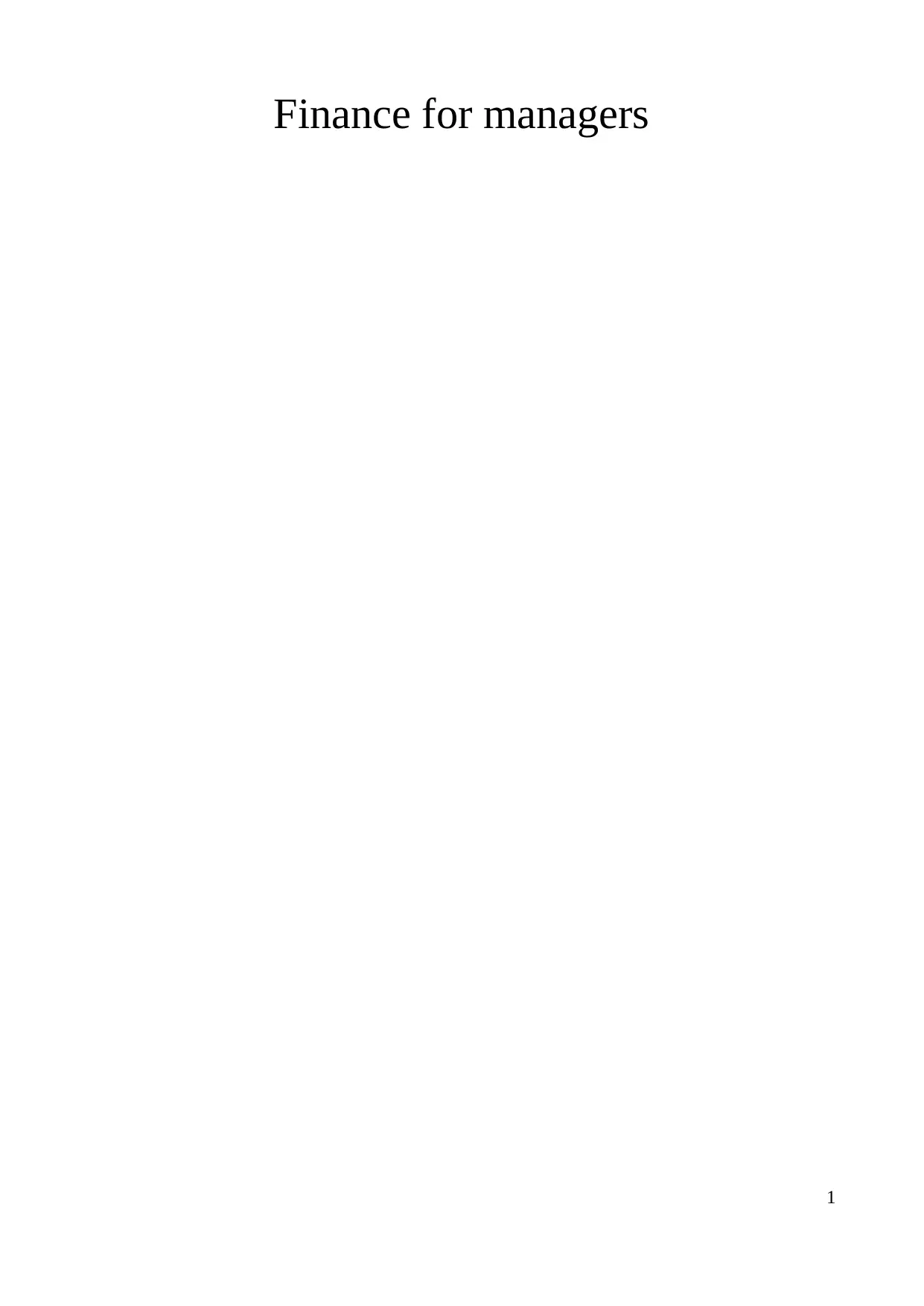
Finance for managers
1
1
Paraphrase This Document
Need a fresh take? Get an instant paraphrase of this document with our AI Paraphraser
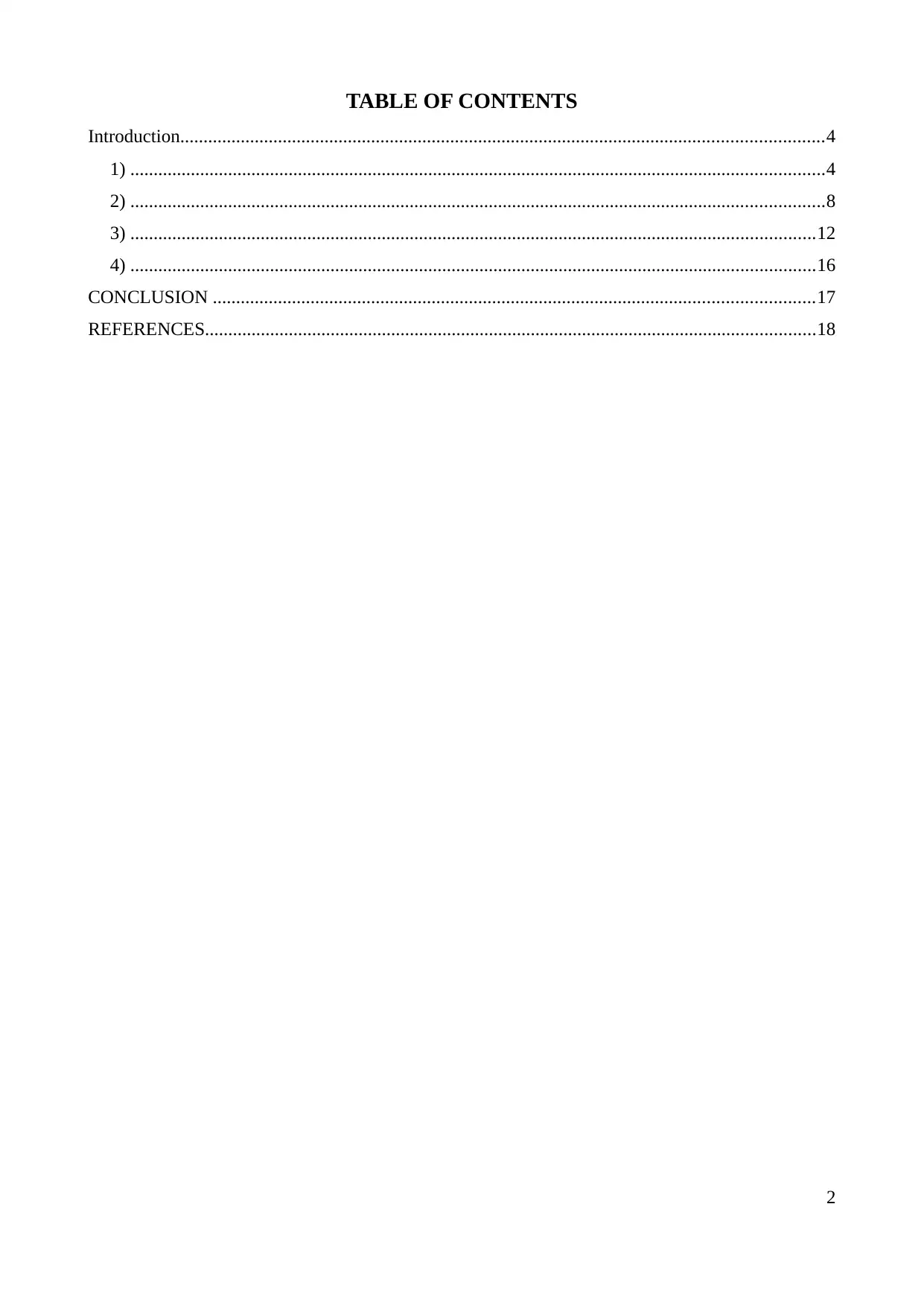
TABLE OF CONTENTS
Introduction..........................................................................................................................................4
1) .....................................................................................................................................................4
2) .....................................................................................................................................................8
3) ...................................................................................................................................................12
4) ...................................................................................................................................................16
CONCLUSION .................................................................................................................................17
REFERENCES...................................................................................................................................18
2
Introduction..........................................................................................................................................4
1) .....................................................................................................................................................4
2) .....................................................................................................................................................8
3) ...................................................................................................................................................12
4) ...................................................................................................................................................16
CONCLUSION .................................................................................................................................17
REFERENCES...................................................................................................................................18
2
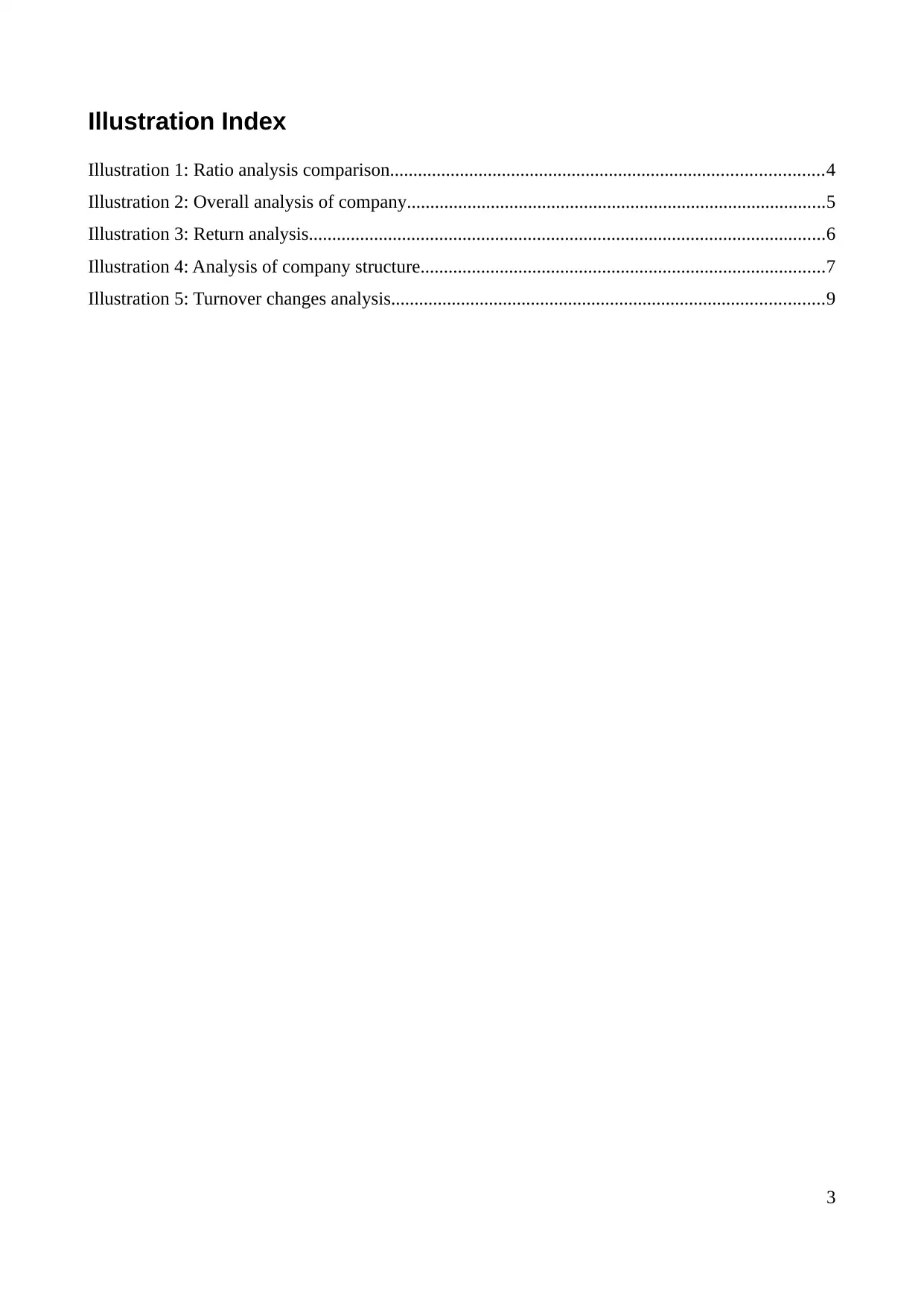
Illustration Index
Illustration 1: Ratio analysis comparison.............................................................................................4
Illustration 2: Overall analysis of company..........................................................................................5
Illustration 3: Return analysis...............................................................................................................6
Illustration 4: Analysis of company structure.......................................................................................7
Illustration 5: Turnover changes analysis.............................................................................................9
3
Illustration 1: Ratio analysis comparison.............................................................................................4
Illustration 2: Overall analysis of company..........................................................................................5
Illustration 3: Return analysis...............................................................................................................6
Illustration 4: Analysis of company structure.......................................................................................7
Illustration 5: Turnover changes analysis.............................................................................................9
3
⊘ This is a preview!⊘
Do you want full access?
Subscribe today to unlock all pages.

Trusted by 1+ million students worldwide
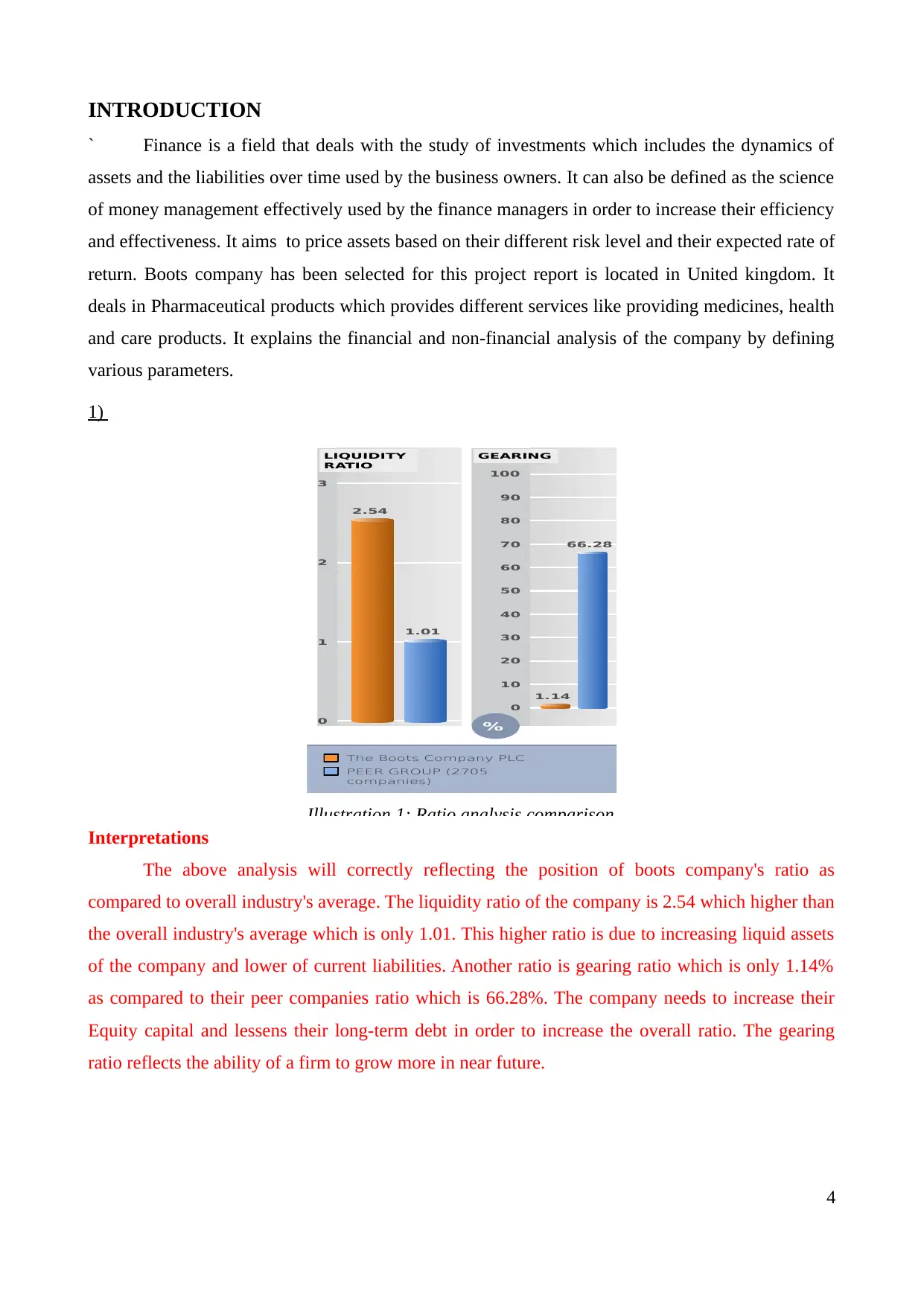
INTRODUCTION
` Finance is a field that deals with the study of investments which includes the dynamics of
assets and the liabilities over time used by the business owners. It can also be defined as the science
of money management effectively used by the finance managers in order to increase their efficiency
and effectiveness. It aims to price assets based on their different risk level and their expected rate of
return. Boots company has been selected for this project report is located in United kingdom. It
deals in Pharmaceutical products which provides different services like providing medicines, health
and care products. It explains the financial and non-financial analysis of the company by defining
various parameters.
1)
The Boots Company PLC
PEER GROUP (2705
companies)
0
10
20
30
40
50
60
70
80
90
100
%
GEARING
1.14
66.28
0
1
2
3
LIQUIDITY
RATIO
2.54
1.01
Illustration 1: Ratio analysis comparison
Interpretations
The above analysis will correctly reflecting the position of boots company's ratio as
compared to overall industry's average. The liquidity ratio of the company is 2.54 which higher than
the overall industry's average which is only 1.01. This higher ratio is due to increasing liquid assets
of the company and lower of current liabilities. Another ratio is gearing ratio which is only 1.14%
as compared to their peer companies ratio which is 66.28%. The company needs to increase their
Equity capital and lessens their long-term debt in order to increase the overall ratio. The gearing
ratio reflects the ability of a firm to grow more in near future.
4
` Finance is a field that deals with the study of investments which includes the dynamics of
assets and the liabilities over time used by the business owners. It can also be defined as the science
of money management effectively used by the finance managers in order to increase their efficiency
and effectiveness. It aims to price assets based on their different risk level and their expected rate of
return. Boots company has been selected for this project report is located in United kingdom. It
deals in Pharmaceutical products which provides different services like providing medicines, health
and care products. It explains the financial and non-financial analysis of the company by defining
various parameters.
1)
The Boots Company PLC
PEER GROUP (2705
companies)
0
10
20
30
40
50
60
70
80
90
100
%
GEARING
1.14
66.28
0
1
2
3
LIQUIDITY
RATIO
2.54
1.01
Illustration 1: Ratio analysis comparison
Interpretations
The above analysis will correctly reflecting the position of boots company's ratio as
compared to overall industry's average. The liquidity ratio of the company is 2.54 which higher than
the overall industry's average which is only 1.01. This higher ratio is due to increasing liquid assets
of the company and lower of current liabilities. Another ratio is gearing ratio which is only 1.14%
as compared to their peer companies ratio which is 66.28%. The company needs to increase their
Equity capital and lessens their long-term debt in order to increase the overall ratio. The gearing
ratio reflects the ability of a firm to grow more in near future.
4
Paraphrase This Document
Need a fresh take? Get an instant paraphrase of this document with our AI Paraphraser
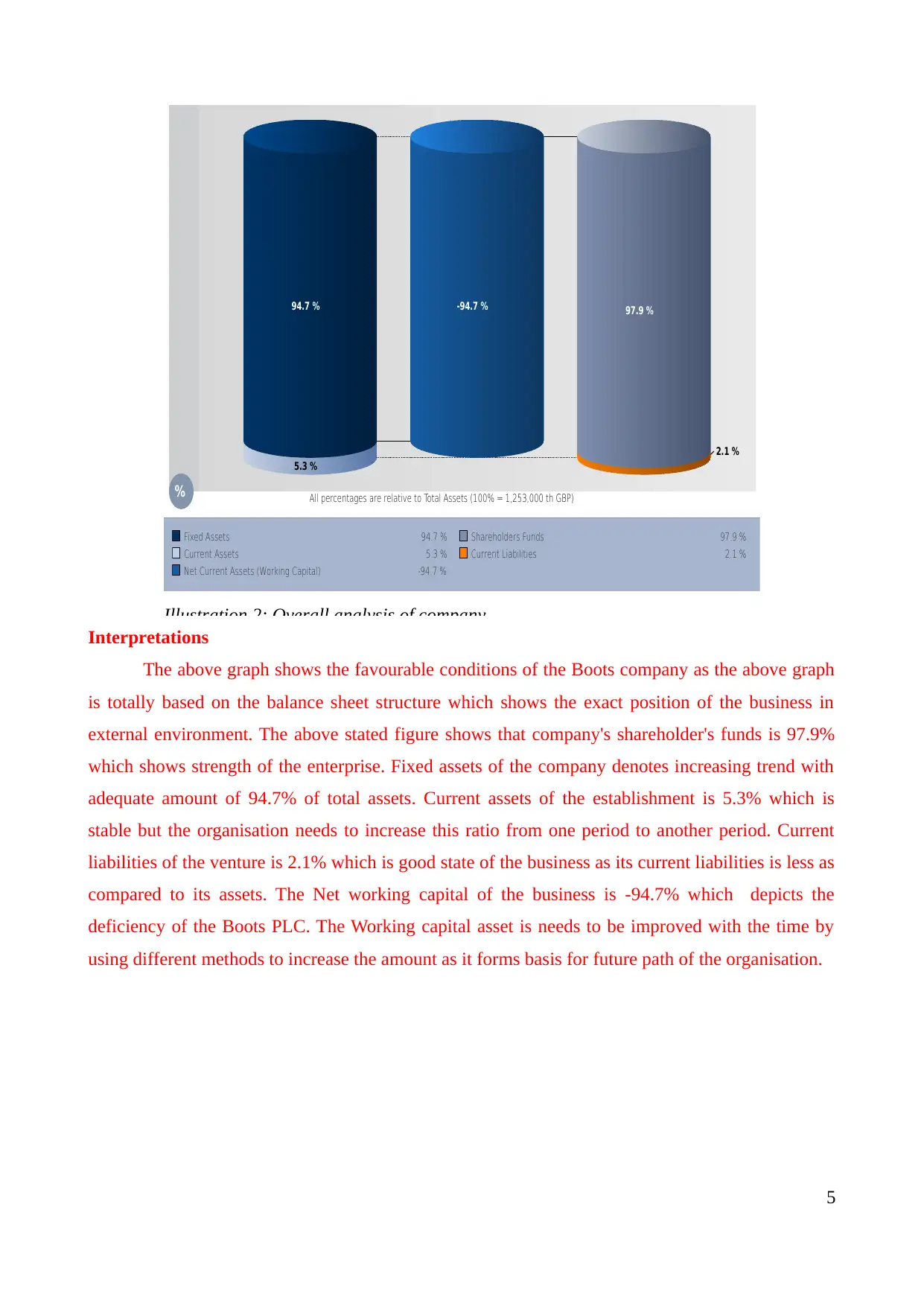
Fixed Assets 94.7 % Shareholders Funds 97.9 %
Current Assets 5.3 % Current Liabilities 2.1 %
Net Current Assets (Working Capital) -94.7 %
% All percentages are relative to Total Assets (100% = 1,253,000 th GBP)
5.3 %
94.7 % 97.9 %
2.1 %
-94.7 %
Illustration 2: Overall analysis of company
Interpretations
The above graph shows the favourable conditions of the Boots company as the above graph
is totally based on the balance sheet structure which shows the exact position of the business in
external environment. The above stated figure shows that company's shareholder's funds is 97.9%
which shows strength of the enterprise. Fixed assets of the company denotes increasing trend with
adequate amount of 94.7% of total assets. Current assets of the establishment is 5.3% which is
stable but the organisation needs to increase this ratio from one period to another period. Current
liabilities of the venture is 2.1% which is good state of the business as its current liabilities is less as
compared to its assets. The Net working capital of the business is -94.7% which depicts the
deficiency of the Boots PLC. The Working capital asset is needs to be improved with the time by
using different methods to increase the amount as it forms basis for future path of the organisation.
5
Current Assets 5.3 % Current Liabilities 2.1 %
Net Current Assets (Working Capital) -94.7 %
% All percentages are relative to Total Assets (100% = 1,253,000 th GBP)
5.3 %
94.7 % 97.9 %
2.1 %
-94.7 %
Illustration 2: Overall analysis of company
Interpretations
The above graph shows the favourable conditions of the Boots company as the above graph
is totally based on the balance sheet structure which shows the exact position of the business in
external environment. The above stated figure shows that company's shareholder's funds is 97.9%
which shows strength of the enterprise. Fixed assets of the company denotes increasing trend with
adequate amount of 94.7% of total assets. Current assets of the establishment is 5.3% which is
stable but the organisation needs to increase this ratio from one period to another period. Current
liabilities of the venture is 2.1% which is good state of the business as its current liabilities is less as
compared to its assets. The Net working capital of the business is -94.7% which depicts the
deficiency of the Boots PLC. The Working capital asset is needs to be improved with the time by
using different methods to increase the amount as it forms basis for future path of the organisation.
5
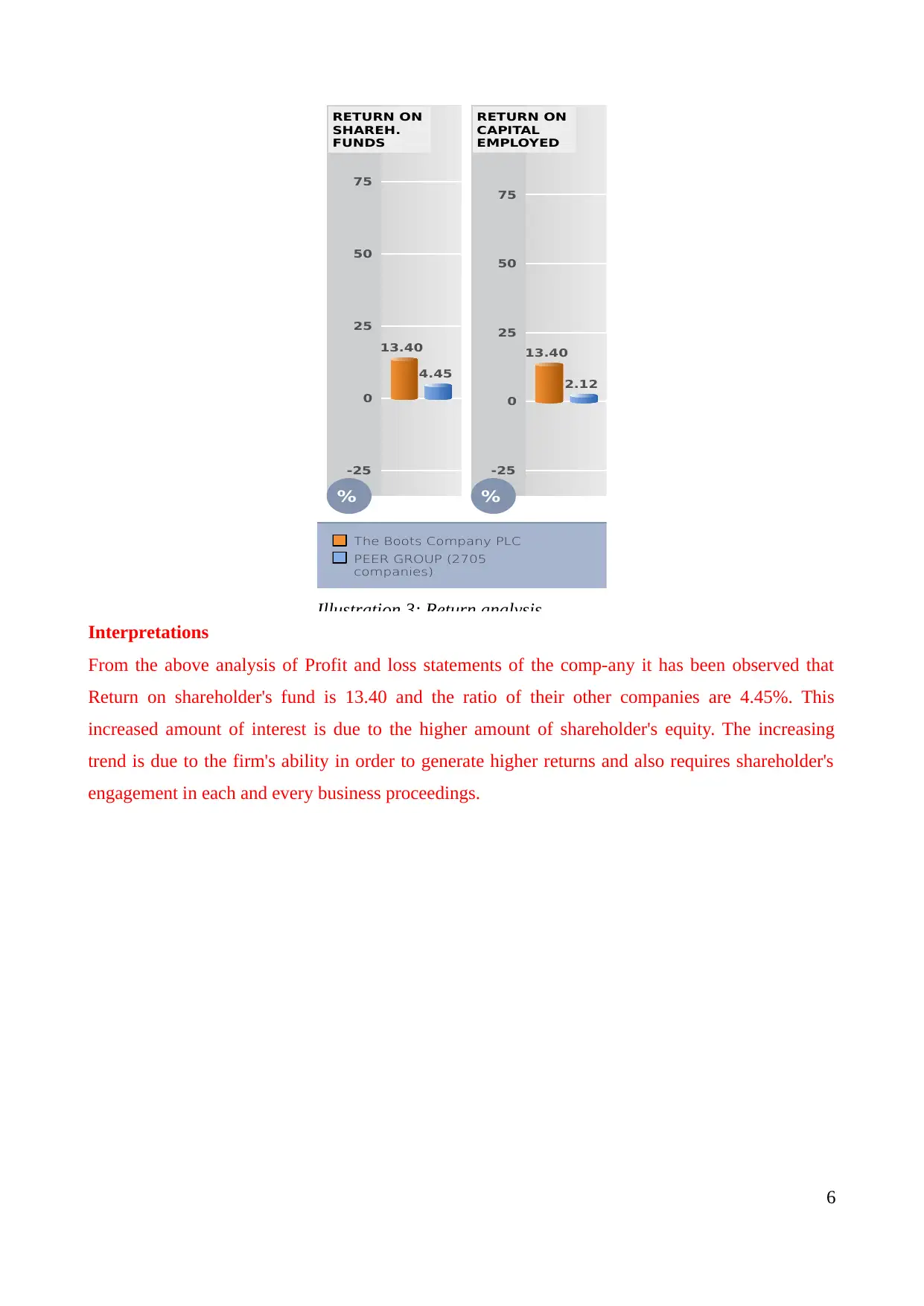
The Boots Company PLC
PEER GROUP (2705
companies)
-25
0
25
50
75
%
RETURN ON
CAPITAL
EMPLOYED
13.40
2.12
-25
0
25
50
75
%
RETURN ON
SHAREH.
FUNDS
13.40
4.45
Illustration 3: Return analysis
Interpretations
From the above analysis of Profit and loss statements of the comp-any it has been observed that
Return on shareholder's fund is 13.40 and the ratio of their other companies are 4.45%. This
increased amount of interest is due to the higher amount of shareholder's equity. The increasing
trend is due to the firm's ability in order to generate higher returns and also requires shareholder's
engagement in each and every business proceedings.
6
PEER GROUP (2705
companies)
-25
0
25
50
75
%
RETURN ON
CAPITAL
EMPLOYED
13.40
2.12
-25
0
25
50
75
%
RETURN ON
SHAREH.
FUNDS
13.40
4.45
Illustration 3: Return analysis
Interpretations
From the above analysis of Profit and loss statements of the comp-any it has been observed that
Return on shareholder's fund is 13.40 and the ratio of their other companies are 4.45%. This
increased amount of interest is due to the higher amount of shareholder's equity. The increasing
trend is due to the firm's ability in order to generate higher returns and also requires shareholder's
engagement in each and every business proceedings.
6
⊘ This is a preview!⊘
Do you want full access?
Subscribe today to unlock all pages.

Trusted by 1+ million students worldwide
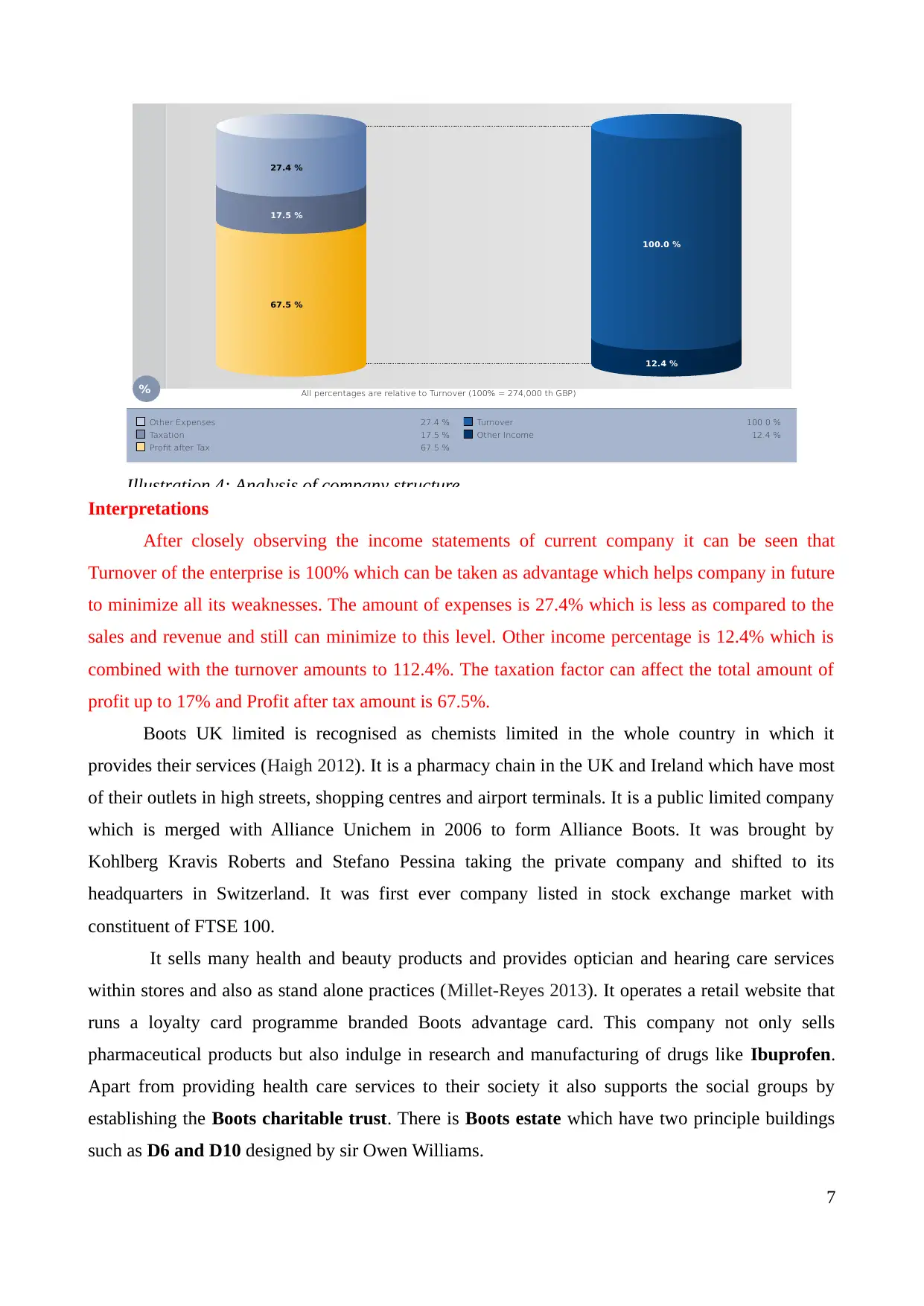
Other Expenses 27.4 % Turnover 100.0 %
Taxation 17.5 % Other Income 12.4 %
Profit after Tax 67.5 %
% All percentages are relative to Turnover (100% = 274,000 th GBP)
67.5 %
17.5 %
27.4 %
12.4 %
100.0 %
Illustration 4: Analysis of company structure
Interpretations
After closely observing the income statements of current company it can be seen that
Turnover of the enterprise is 100% which can be taken as advantage which helps company in future
to minimize all its weaknesses. The amount of expenses is 27.4% which is less as compared to the
sales and revenue and still can minimize to this level. Other income percentage is 12.4% which is
combined with the turnover amounts to 112.4%. The taxation factor can affect the total amount of
profit up to 17% and Profit after tax amount is 67.5%.
Boots UK limited is recognised as chemists limited in the whole country in which it
provides their services (Haigh 2012). It is a pharmacy chain in the UK and Ireland which have most
of their outlets in high streets, shopping centres and airport terminals. It is a public limited company
which is merged with Alliance Unichem in 2006 to form Alliance Boots. It was brought by
Kohlberg Kravis Roberts and Stefano Pessina taking the private company and shifted to its
headquarters in Switzerland. It was first ever company listed in stock exchange market with
constituent of FTSE 100.
It sells many health and beauty products and provides optician and hearing care services
within stores and also as stand alone practices (Millet-Reyes 2013). It operates a retail website that
runs a loyalty card programme branded Boots advantage card. This company not only sells
pharmaceutical products but also indulge in research and manufacturing of drugs like Ibuprofen.
Apart from providing health care services to their society it also supports the social groups by
establishing the Boots charitable trust. There is Boots estate which have two principle buildings
such as D6 and D10 designed by sir Owen Williams.
7
Taxation 17.5 % Other Income 12.4 %
Profit after Tax 67.5 %
% All percentages are relative to Turnover (100% = 274,000 th GBP)
67.5 %
17.5 %
27.4 %
12.4 %
100.0 %
Illustration 4: Analysis of company structure
Interpretations
After closely observing the income statements of current company it can be seen that
Turnover of the enterprise is 100% which can be taken as advantage which helps company in future
to minimize all its weaknesses. The amount of expenses is 27.4% which is less as compared to the
sales and revenue and still can minimize to this level. Other income percentage is 12.4% which is
combined with the turnover amounts to 112.4%. The taxation factor can affect the total amount of
profit up to 17% and Profit after tax amount is 67.5%.
Boots UK limited is recognised as chemists limited in the whole country in which it
provides their services (Haigh 2012). It is a pharmacy chain in the UK and Ireland which have most
of their outlets in high streets, shopping centres and airport terminals. It is a public limited company
which is merged with Alliance Unichem in 2006 to form Alliance Boots. It was brought by
Kohlberg Kravis Roberts and Stefano Pessina taking the private company and shifted to its
headquarters in Switzerland. It was first ever company listed in stock exchange market with
constituent of FTSE 100.
It sells many health and beauty products and provides optician and hearing care services
within stores and also as stand alone practices (Millet-Reyes 2013). It operates a retail website that
runs a loyalty card programme branded Boots advantage card. This company not only sells
pharmaceutical products but also indulge in research and manufacturing of drugs like Ibuprofen.
Apart from providing health care services to their society it also supports the social groups by
establishing the Boots charitable trust. There is Boots estate which have two principle buildings
such as D6 and D10 designed by sir Owen Williams.
7
Paraphrase This Document
Need a fresh take? Get an instant paraphrase of this document with our AI Paraphraser
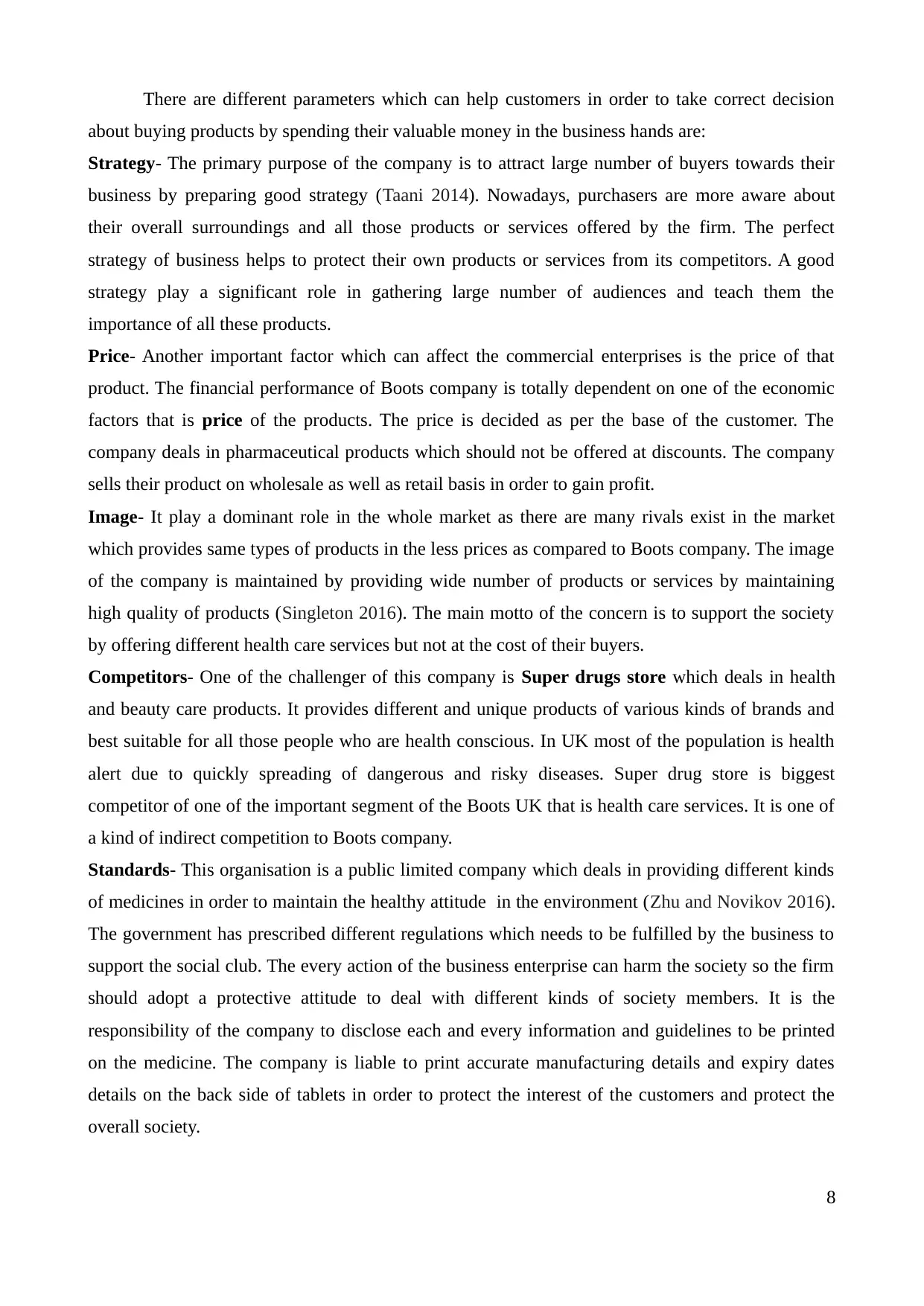
There are different parameters which can help customers in order to take correct decision
about buying products by spending their valuable money in the business hands are:
Strategy- The primary purpose of the company is to attract large number of buyers towards their
business by preparing good strategy (Taani 2014). Nowadays, purchasers are more aware about
their overall surroundings and all those products or services offered by the firm. The perfect
strategy of business helps to protect their own products or services from its competitors. A good
strategy play a significant role in gathering large number of audiences and teach them the
importance of all these products.
Price- Another important factor which can affect the commercial enterprises is the price of that
product. The financial performance of Boots company is totally dependent on one of the economic
factors that is price of the products. The price is decided as per the base of the customer. The
company deals in pharmaceutical products which should not be offered at discounts. The company
sells their product on wholesale as well as retail basis in order to gain profit.
Image- It play a dominant role in the whole market as there are many rivals exist in the market
which provides same types of products in the less prices as compared to Boots company. The image
of the company is maintained by providing wide number of products or services by maintaining
high quality of products (Singleton 2016). The main motto of the concern is to support the society
by offering different health care services but not at the cost of their buyers.
Competitors- One of the challenger of this company is Super drugs store which deals in health
and beauty care products. It provides different and unique products of various kinds of brands and
best suitable for all those people who are health conscious. In UK most of the population is health
alert due to quickly spreading of dangerous and risky diseases. Super drug store is biggest
competitor of one of the important segment of the Boots UK that is health care services. It is one of
a kind of indirect competition to Boots company.
Standards- This organisation is a public limited company which deals in providing different kinds
of medicines in order to maintain the healthy attitude in the environment (Zhu and Novikov 2016).
The government has prescribed different regulations which needs to be fulfilled by the business to
support the social club. The every action of the business enterprise can harm the society so the firm
should adopt a protective attitude to deal with different kinds of society members. It is the
responsibility of the company to disclose each and every information and guidelines to be printed
on the medicine. The company is liable to print accurate manufacturing details and expiry dates
details on the back side of tablets in order to protect the interest of the customers and protect the
overall society.
8
about buying products by spending their valuable money in the business hands are:
Strategy- The primary purpose of the company is to attract large number of buyers towards their
business by preparing good strategy (Taani 2014). Nowadays, purchasers are more aware about
their overall surroundings and all those products or services offered by the firm. The perfect
strategy of business helps to protect their own products or services from its competitors. A good
strategy play a significant role in gathering large number of audiences and teach them the
importance of all these products.
Price- Another important factor which can affect the commercial enterprises is the price of that
product. The financial performance of Boots company is totally dependent on one of the economic
factors that is price of the products. The price is decided as per the base of the customer. The
company deals in pharmaceutical products which should not be offered at discounts. The company
sells their product on wholesale as well as retail basis in order to gain profit.
Image- It play a dominant role in the whole market as there are many rivals exist in the market
which provides same types of products in the less prices as compared to Boots company. The image
of the company is maintained by providing wide number of products or services by maintaining
high quality of products (Singleton 2016). The main motto of the concern is to support the society
by offering different health care services but not at the cost of their buyers.
Competitors- One of the challenger of this company is Super drugs store which deals in health
and beauty care products. It provides different and unique products of various kinds of brands and
best suitable for all those people who are health conscious. In UK most of the population is health
alert due to quickly spreading of dangerous and risky diseases. Super drug store is biggest
competitor of one of the important segment of the Boots UK that is health care services. It is one of
a kind of indirect competition to Boots company.
Standards- This organisation is a public limited company which deals in providing different kinds
of medicines in order to maintain the healthy attitude in the environment (Zhu and Novikov 2016).
The government has prescribed different regulations which needs to be fulfilled by the business to
support the social club. The every action of the business enterprise can harm the society so the firm
should adopt a protective attitude to deal with different kinds of society members. It is the
responsibility of the company to disclose each and every information and guidelines to be printed
on the medicine. The company is liable to print accurate manufacturing details and expiry dates
details on the back side of tablets in order to protect the interest of the customers and protect the
overall society.
8
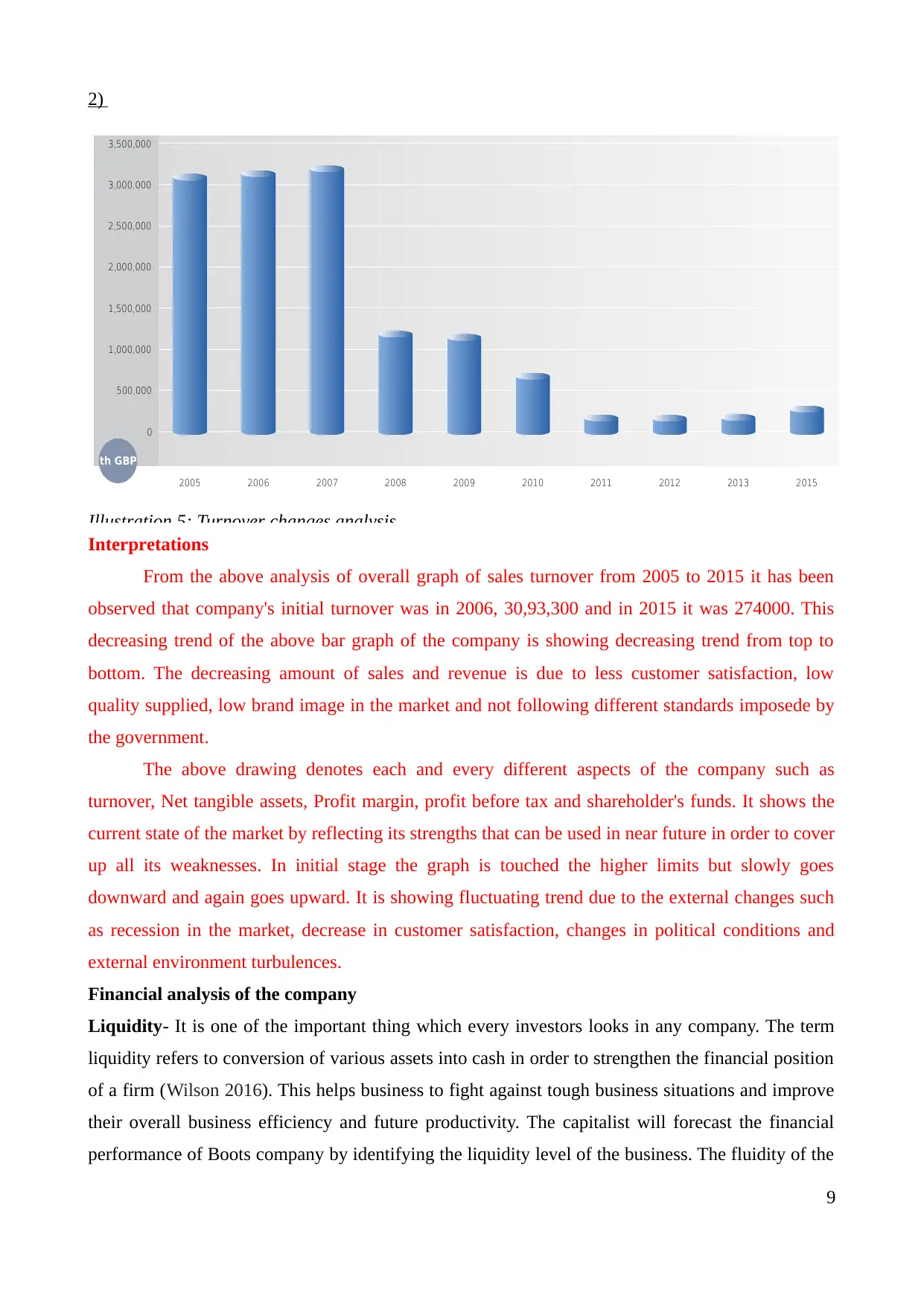
2)
0
500,000
1,000,000
1,500,000
2,000,000
2,500,000
3,000,000
3,500,000
th GBP
2005 2006 2007 2008 2009 2010 2011 2012 2013 2015
Illustration 5: Turnover changes analysis
Interpretations
From the above analysis of overall graph of sales turnover from 2005 to 2015 it has been
observed that company's initial turnover was in 2006, 30,93,300 and in 2015 it was 274000. This
decreasing trend of the above bar graph of the company is showing decreasing trend from top to
bottom. The decreasing amount of sales and revenue is due to less customer satisfaction, low
quality supplied, low brand image in the market and not following different standards imposede by
the government.
The above drawing denotes each and every different aspects of the company such as
turnover, Net tangible assets, Profit margin, profit before tax and shareholder's funds. It shows the
current state of the market by reflecting its strengths that can be used in near future in order to cover
up all its weaknesses. In initial stage the graph is touched the higher limits but slowly goes
downward and again goes upward. It is showing fluctuating trend due to the external changes such
as recession in the market, decrease in customer satisfaction, changes in political conditions and
external environment turbulences.
Financial analysis of the company
Liquidity- It is one of the important thing which every investors looks in any company. The term
liquidity refers to conversion of various assets into cash in order to strengthen the financial position
of a firm (Wilson 2016). This helps business to fight against tough business situations and improve
their overall business efficiency and future productivity. The capitalist will forecast the financial
performance of Boots company by identifying the liquidity level of the business. The fluidity of the
9
0
500,000
1,000,000
1,500,000
2,000,000
2,500,000
3,000,000
3,500,000
th GBP
2005 2006 2007 2008 2009 2010 2011 2012 2013 2015
Illustration 5: Turnover changes analysis
Interpretations
From the above analysis of overall graph of sales turnover from 2005 to 2015 it has been
observed that company's initial turnover was in 2006, 30,93,300 and in 2015 it was 274000. This
decreasing trend of the above bar graph of the company is showing decreasing trend from top to
bottom. The decreasing amount of sales and revenue is due to less customer satisfaction, low
quality supplied, low brand image in the market and not following different standards imposede by
the government.
The above drawing denotes each and every different aspects of the company such as
turnover, Net tangible assets, Profit margin, profit before tax and shareholder's funds. It shows the
current state of the market by reflecting its strengths that can be used in near future in order to cover
up all its weaknesses. In initial stage the graph is touched the higher limits but slowly goes
downward and again goes upward. It is showing fluctuating trend due to the external changes such
as recession in the market, decrease in customer satisfaction, changes in political conditions and
external environment turbulences.
Financial analysis of the company
Liquidity- It is one of the important thing which every investors looks in any company. The term
liquidity refers to conversion of various assets into cash in order to strengthen the financial position
of a firm (Wilson 2016). This helps business to fight against tough business situations and improve
their overall business efficiency and future productivity. The capitalist will forecast the financial
performance of Boots company by identifying the liquidity level of the business. The fluidity of the
9
⊘ This is a preview!⊘
Do you want full access?
Subscribe today to unlock all pages.

Trusted by 1+ million students worldwide
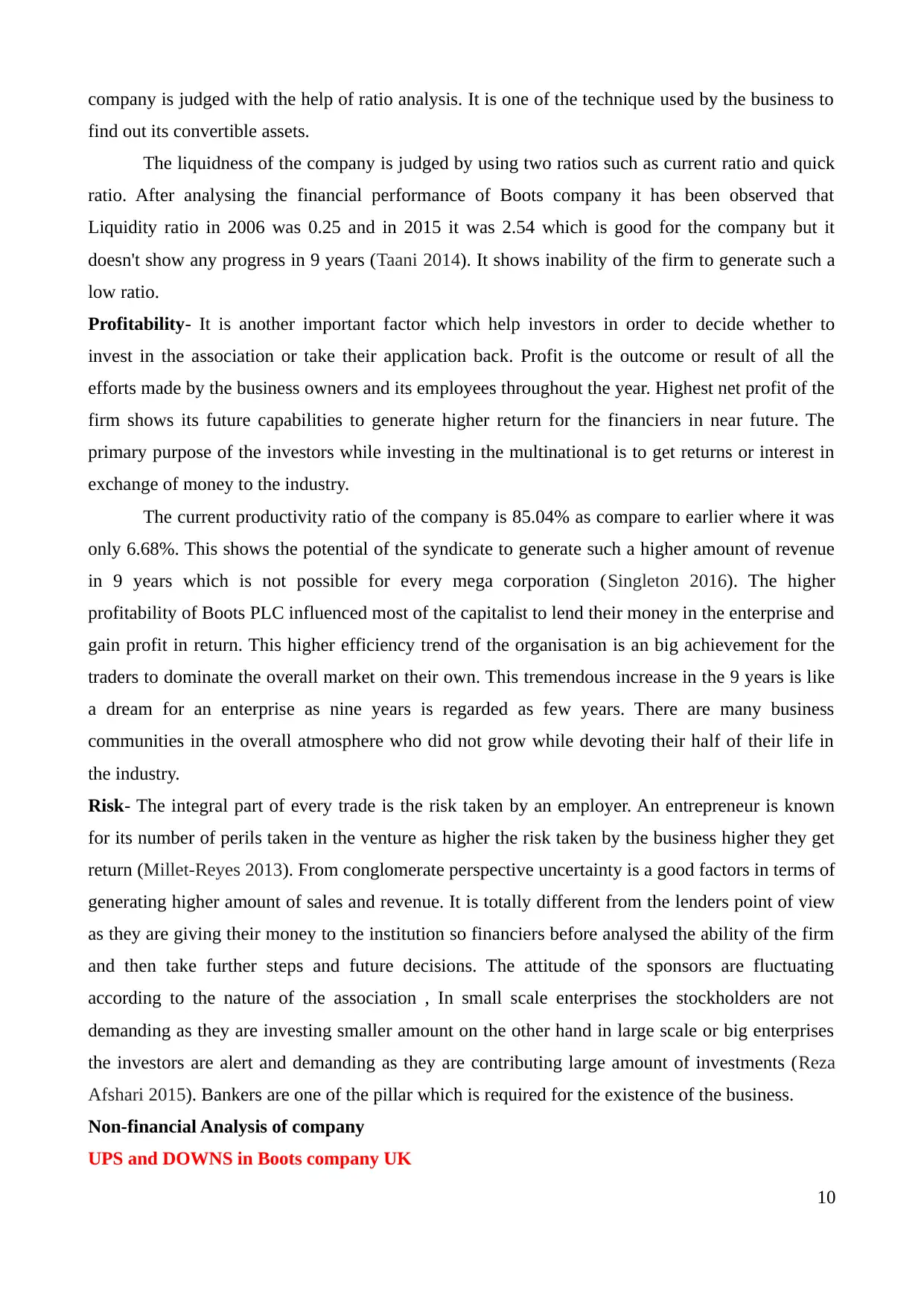
company is judged with the help of ratio analysis. It is one of the technique used by the business to
find out its convertible assets.
The liquidness of the company is judged by using two ratios such as current ratio and quick
ratio. After analysing the financial performance of Boots company it has been observed that
Liquidity ratio in 2006 was 0.25 and in 2015 it was 2.54 which is good for the company but it
doesn't show any progress in 9 years (Taani 2014). It shows inability of the firm to generate such a
low ratio.
Profitability- It is another important factor which help investors in order to decide whether to
invest in the association or take their application back. Profit is the outcome or result of all the
efforts made by the business owners and its employees throughout the year. Highest net profit of the
firm shows its future capabilities to generate higher return for the financiers in near future. The
primary purpose of the investors while investing in the multinational is to get returns or interest in
exchange of money to the industry.
The current productivity ratio of the company is 85.04% as compare to earlier where it was
only 6.68%. This shows the potential of the syndicate to generate such a higher amount of revenue
in 9 years which is not possible for every mega corporation (Singleton 2016). The higher
profitability of Boots PLC influenced most of the capitalist to lend their money in the enterprise and
gain profit in return. This higher efficiency trend of the organisation is an big achievement for the
traders to dominate the overall market on their own. This tremendous increase in the 9 years is like
a dream for an enterprise as nine years is regarded as few years. There are many business
communities in the overall atmosphere who did not grow while devoting their half of their life in
the industry.
Risk- The integral part of every trade is the risk taken by an employer. An entrepreneur is known
for its number of perils taken in the venture as higher the risk taken by the business higher they get
return (Millet-Reyes 2013). From conglomerate perspective uncertainty is a good factors in terms of
generating higher amount of sales and revenue. It is totally different from the lenders point of view
as they are giving their money to the institution so financiers before analysed the ability of the firm
and then take further steps and future decisions. The attitude of the sponsors are fluctuating
according to the nature of the association , In small scale enterprises the stockholders are not
demanding as they are investing smaller amount on the other hand in large scale or big enterprises
the investors are alert and demanding as they are contributing large amount of investments (Reza
Afshari 2015). Bankers are one of the pillar which is required for the existence of the business.
Non-financial Analysis of company
UPS and DOWNS in Boots company UK
10
find out its convertible assets.
The liquidness of the company is judged by using two ratios such as current ratio and quick
ratio. After analysing the financial performance of Boots company it has been observed that
Liquidity ratio in 2006 was 0.25 and in 2015 it was 2.54 which is good for the company but it
doesn't show any progress in 9 years (Taani 2014). It shows inability of the firm to generate such a
low ratio.
Profitability- It is another important factor which help investors in order to decide whether to
invest in the association or take their application back. Profit is the outcome or result of all the
efforts made by the business owners and its employees throughout the year. Highest net profit of the
firm shows its future capabilities to generate higher return for the financiers in near future. The
primary purpose of the investors while investing in the multinational is to get returns or interest in
exchange of money to the industry.
The current productivity ratio of the company is 85.04% as compare to earlier where it was
only 6.68%. This shows the potential of the syndicate to generate such a higher amount of revenue
in 9 years which is not possible for every mega corporation (Singleton 2016). The higher
profitability of Boots PLC influenced most of the capitalist to lend their money in the enterprise and
gain profit in return. This higher efficiency trend of the organisation is an big achievement for the
traders to dominate the overall market on their own. This tremendous increase in the 9 years is like
a dream for an enterprise as nine years is regarded as few years. There are many business
communities in the overall atmosphere who did not grow while devoting their half of their life in
the industry.
Risk- The integral part of every trade is the risk taken by an employer. An entrepreneur is known
for its number of perils taken in the venture as higher the risk taken by the business higher they get
return (Millet-Reyes 2013). From conglomerate perspective uncertainty is a good factors in terms of
generating higher amount of sales and revenue. It is totally different from the lenders point of view
as they are giving their money to the institution so financiers before analysed the ability of the firm
and then take further steps and future decisions. The attitude of the sponsors are fluctuating
according to the nature of the association , In small scale enterprises the stockholders are not
demanding as they are investing smaller amount on the other hand in large scale or big enterprises
the investors are alert and demanding as they are contributing large amount of investments (Reza
Afshari 2015). Bankers are one of the pillar which is required for the existence of the business.
Non-financial Analysis of company
UPS and DOWNS in Boots company UK
10
Paraphrase This Document
Need a fresh take? Get an instant paraphrase of this document with our AI Paraphraser
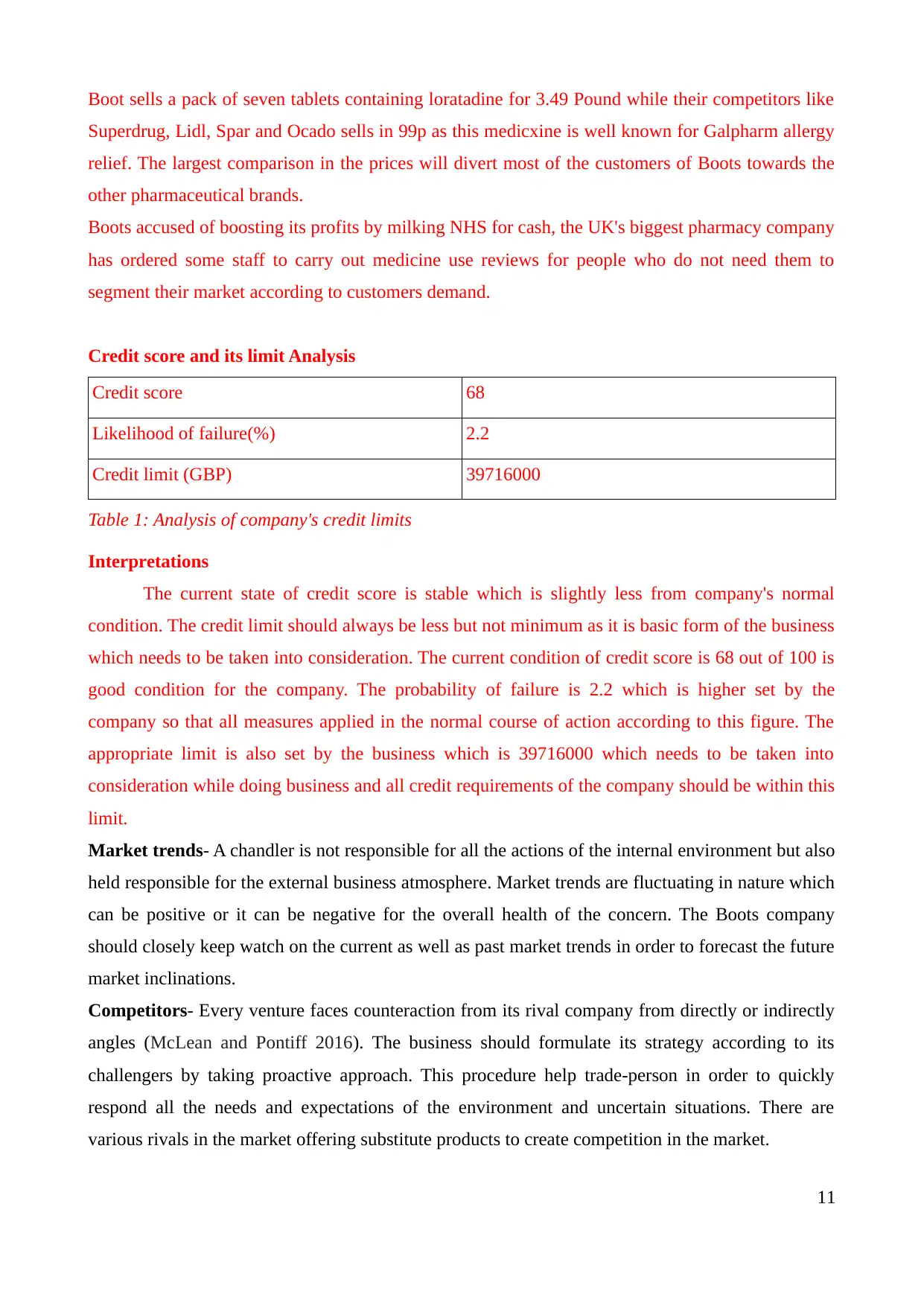
Boot sells a pack of seven tablets containing loratadine for 3.49 Pound while their competitors like
Superdrug, Lidl, Spar and Ocado sells in 99p as this medicxine is well known for Galpharm allergy
relief. The largest comparison in the prices will divert most of the customers of Boots towards the
other pharmaceutical brands.
Boots accused of boosting its profits by milking NHS for cash, the UK's biggest pharmacy company
has ordered some staff to carry out medicine use reviews for people who do not need them to
segment their market according to customers demand.
Credit score and its limit Analysis
Credit score 68
Likelihood of failure(%) 2.2
Credit limit (GBP) 39716000
Table 1: Analysis of company's credit limits
Interpretations
The current state of credit score is stable which is slightly less from company's normal
condition. The credit limit should always be less but not minimum as it is basic form of the business
which needs to be taken into consideration. The current condition of credit score is 68 out of 100 is
good condition for the company. The probability of failure is 2.2 which is higher set by the
company so that all measures applied in the normal course of action according to this figure. The
appropriate limit is also set by the business which is 39716000 which needs to be taken into
consideration while doing business and all credit requirements of the company should be within this
limit.
Market trends- A chandler is not responsible for all the actions of the internal environment but also
held responsible for the external business atmosphere. Market trends are fluctuating in nature which
can be positive or it can be negative for the overall health of the concern. The Boots company
should closely keep watch on the current as well as past market trends in order to forecast the future
market inclinations.
Competitors- Every venture faces counteraction from its rival company from directly or indirectly
angles (McLean and Pontiff 2016). The business should formulate its strategy according to its
challengers by taking proactive approach. This procedure help trade-person in order to quickly
respond all the needs and expectations of the environment and uncertain situations. There are
various rivals in the market offering substitute products to create competition in the market.
11
Superdrug, Lidl, Spar and Ocado sells in 99p as this medicxine is well known for Galpharm allergy
relief. The largest comparison in the prices will divert most of the customers of Boots towards the
other pharmaceutical brands.
Boots accused of boosting its profits by milking NHS for cash, the UK's biggest pharmacy company
has ordered some staff to carry out medicine use reviews for people who do not need them to
segment their market according to customers demand.
Credit score and its limit Analysis
Credit score 68
Likelihood of failure(%) 2.2
Credit limit (GBP) 39716000
Table 1: Analysis of company's credit limits
Interpretations
The current state of credit score is stable which is slightly less from company's normal
condition. The credit limit should always be less but not minimum as it is basic form of the business
which needs to be taken into consideration. The current condition of credit score is 68 out of 100 is
good condition for the company. The probability of failure is 2.2 which is higher set by the
company so that all measures applied in the normal course of action according to this figure. The
appropriate limit is also set by the business which is 39716000 which needs to be taken into
consideration while doing business and all credit requirements of the company should be within this
limit.
Market trends- A chandler is not responsible for all the actions of the internal environment but also
held responsible for the external business atmosphere. Market trends are fluctuating in nature which
can be positive or it can be negative for the overall health of the concern. The Boots company
should closely keep watch on the current as well as past market trends in order to forecast the future
market inclinations.
Competitors- Every venture faces counteraction from its rival company from directly or indirectly
angles (McLean and Pontiff 2016). The business should formulate its strategy according to its
challengers by taking proactive approach. This procedure help trade-person in order to quickly
respond all the needs and expectations of the environment and uncertain situations. There are
various rivals in the market offering substitute products to create competition in the market.
11
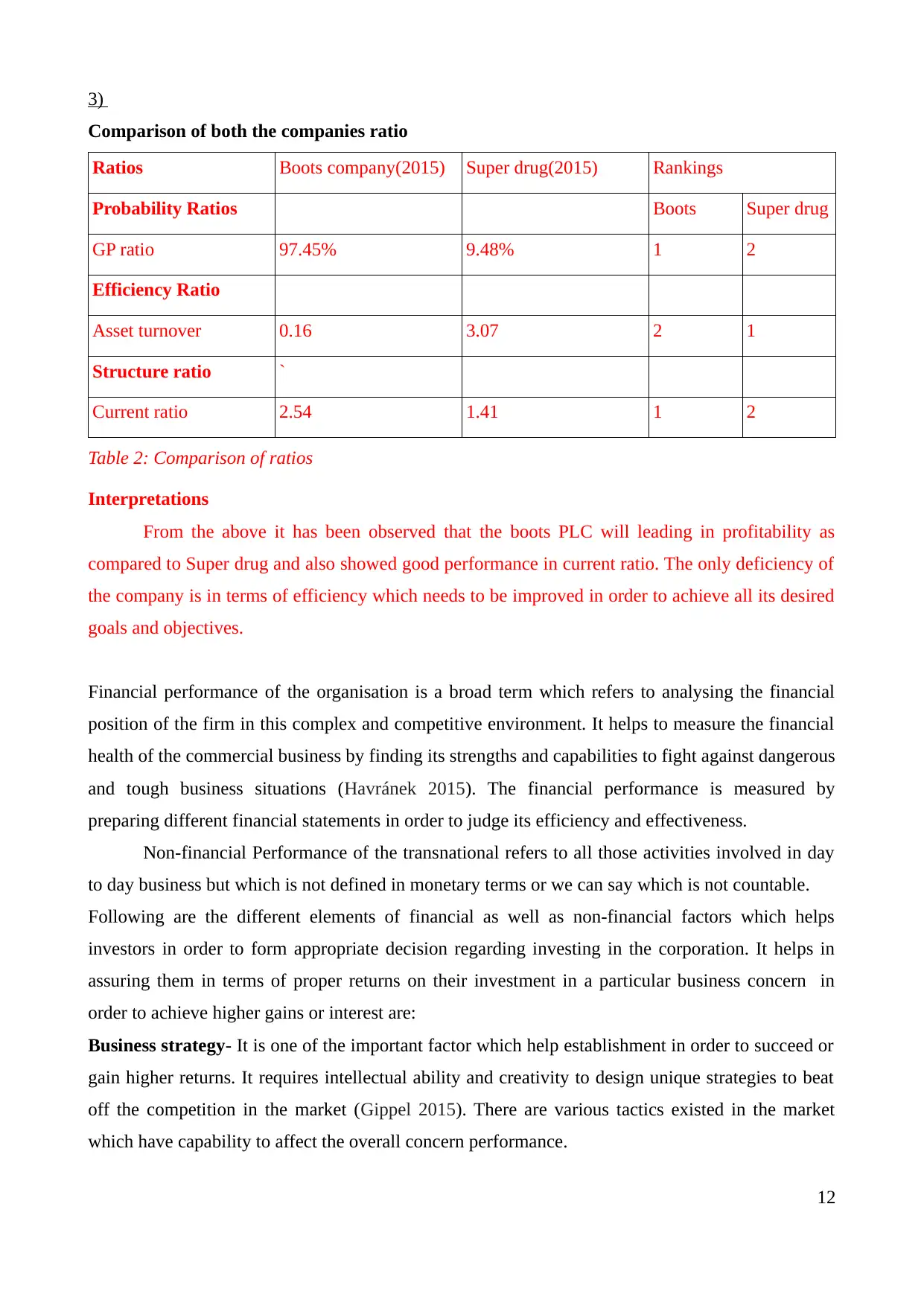
3)
Comparison of both the companies ratio
Ratios Boots company(2015) Super drug(2015) Rankings
Probability Ratios Boots Super drug
GP ratio 97.45% 9.48% 1 2
Efficiency Ratio
Asset turnover 0.16 3.07 2 1
Structure ratio `
Current ratio 2.54 1.41 1 2
Table 2: Comparison of ratios
Interpretations
From the above it has been observed that the boots PLC will leading in profitability as
compared to Super drug and also showed good performance in current ratio. The only deficiency of
the company is in terms of efficiency which needs to be improved in order to achieve all its desired
goals and objectives.
Financial performance of the organisation is a broad term which refers to analysing the financial
position of the firm in this complex and competitive environment. It helps to measure the financial
health of the commercial business by finding its strengths and capabilities to fight against dangerous
and tough business situations (Havránek 2015). The financial performance is measured by
preparing different financial statements in order to judge its efficiency and effectiveness.
Non-financial Performance of the transnational refers to all those activities involved in day
to day business but which is not defined in monetary terms or we can say which is not countable.
Following are the different elements of financial as well as non-financial factors which helps
investors in order to form appropriate decision regarding investing in the corporation. It helps in
assuring them in terms of proper returns on their investment in a particular business concern in
order to achieve higher gains or interest are:
Business strategy- It is one of the important factor which help establishment in order to succeed or
gain higher returns. It requires intellectual ability and creativity to design unique strategies to beat
off the competition in the market (Gippel 2015). There are various tactics existed in the market
which have capability to affect the overall concern performance.
12
Comparison of both the companies ratio
Ratios Boots company(2015) Super drug(2015) Rankings
Probability Ratios Boots Super drug
GP ratio 97.45% 9.48% 1 2
Efficiency Ratio
Asset turnover 0.16 3.07 2 1
Structure ratio `
Current ratio 2.54 1.41 1 2
Table 2: Comparison of ratios
Interpretations
From the above it has been observed that the boots PLC will leading in profitability as
compared to Super drug and also showed good performance in current ratio. The only deficiency of
the company is in terms of efficiency which needs to be improved in order to achieve all its desired
goals and objectives.
Financial performance of the organisation is a broad term which refers to analysing the financial
position of the firm in this complex and competitive environment. It helps to measure the financial
health of the commercial business by finding its strengths and capabilities to fight against dangerous
and tough business situations (Havránek 2015). The financial performance is measured by
preparing different financial statements in order to judge its efficiency and effectiveness.
Non-financial Performance of the transnational refers to all those activities involved in day
to day business but which is not defined in monetary terms or we can say which is not countable.
Following are the different elements of financial as well as non-financial factors which helps
investors in order to form appropriate decision regarding investing in the corporation. It helps in
assuring them in terms of proper returns on their investment in a particular business concern in
order to achieve higher gains or interest are:
Business strategy- It is one of the important factor which help establishment in order to succeed or
gain higher returns. It requires intellectual ability and creativity to design unique strategies to beat
off the competition in the market (Gippel 2015). There are various tactics existed in the market
which have capability to affect the overall concern performance.
12
⊘ This is a preview!⊘
Do you want full access?
Subscribe today to unlock all pages.

Trusted by 1+ million students worldwide
1 out of 18
Related Documents
Your All-in-One AI-Powered Toolkit for Academic Success.
+13062052269
info@desklib.com
Available 24*7 on WhatsApp / Email
![[object Object]](/_next/static/media/star-bottom.7253800d.svg)
Unlock your academic potential
Copyright © 2020–2025 A2Z Services. All Rights Reserved. Developed and managed by ZUCOL.




